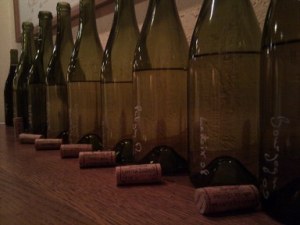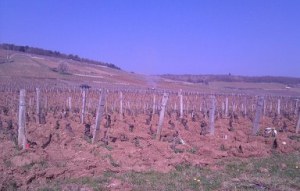Burgundy:The Big and Small of It
Post by Chuck Hayward | April 1, 2011

- Tasting 2009 Whites at Louis Jadot
Our trip to Burgundy has been a spectacular vinous pilgrimage on a number of fronts, but most importantly, we accomplished our mission. Trekking the holy trail that leads south from Dijon through the Cotes-de-Nuits, we spent a couple of days getting up-close-and-personal with winemakers and current releases, as well as assessing what lies ahead. Afterwards, we headed to Beaune and invaded the offices of Louis Jadot where we encountered a positively knee-buckling line-up of wine, including some pretty amazing older vintages.
In addition to getting insight into the wines themselves, these few days also highlighted one of Burgundy's great polemics. It goes something like this:

- The Vineyards Of Romanee-Conti
With the idea that smaller is better, industry pundits and connoisseurs typically hold large wineries and negociants in lesser esteem (sometimes in outright contempt) than small, farmer-winemaker estates. The romantic story of the noble vigneron tilling his vineyard and fighting the large, soul-less city-based firms just to get the mortgage paid speaks to the "little guy" in all of us. But is personal passion inherently superior to corporate pursuits? Critics of big business think so, alleging that large firms lack a unique voice, producing dumbed-down wines aimed at an audience that doesn't know any better.
On the other hand, bigger is not always "badder" and there are certainly a lot of benefits to having cash-flow. Economy of scale, for instance, often translates into lower costs for the consumer. Large corporations are also better able to withstand the whims of Maman Nature, with access to diverse vineyards holdings and more options in the cellar to offset a bad year.

- Navigating Chassagne Montrachet
As is usually the case, the truth lies somewhere closer to the middle. In Burgundy the goal of each winery—big and small—seems to be about making wine that offers a window to the terroir from which it came, so that a Gevrey-Chambertin tastes like a Gevrey-Chambertin, not like it came from Chassagne-Montrachet. Or to take it a a step further, like it could have come from "anywhere". To me, this has less to do with size and funding than with the winemaker's goal of ensuring the finished wine holds true to the Burgundian ideal of wine representing terroir as accurately as possible.
So far on this trip, it has been clear to us that wineries of all sizes can accomplish this and accomplish it well. Accepting the potential for both rather than rejecting one side or the other, opens up a world of possibility. And choice is always a good thing.